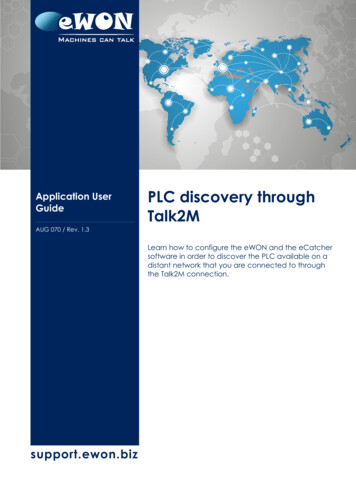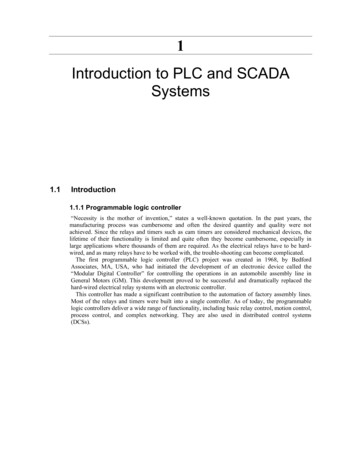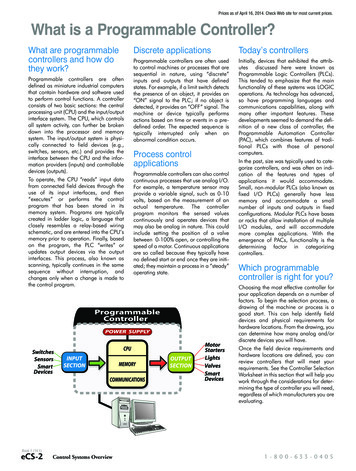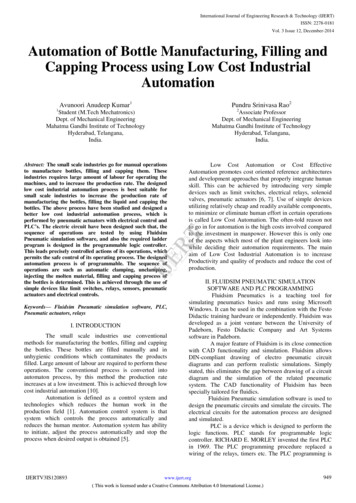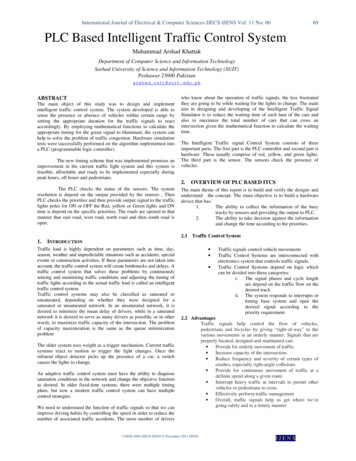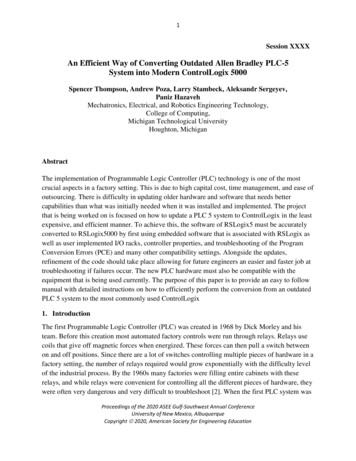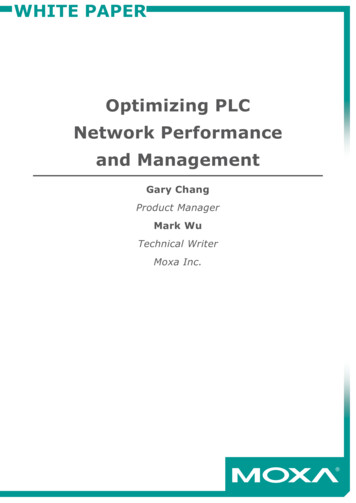
Transcription
WHITE PAPEROptimizing PLCNetwork Performanceand ManagementGary ChangProduct ManagerMark WuTechnical WriterMoxa Inc.
WHITE PAPERPLC Network OptimizationExecutive SummaryTraditional fieldbus networks were, and some still are, isolated automation systems whichrequire extensive local monitoring and routine onsite maintenance. To increase productivityand reduce operating costs, many manufacturers and plant operators have deployed industrialEthernet to converge remotely isolated fieldbus systems for centralized control and monitoring.In addition to systems interoperability, integration of fieldbus segments and industrial Ethernetnetworks will require the optimization of PLC network performance and manageability. Thispaper will discuss how three facets of PLC network optimization can ensure high networkavailability, simplify network monitoring and configuration, and maximize network flexibility.OverviewThe term “automation” was introduced in 1946[1], laterpublished in a magazine in 1948, and defined as “theart of applying mechanical devices to perform thesetasks in timed sequence under pushbutton control atstrategic stations.” What engineers had in mind in the1940s remains fundamentally the same as to whatcontrol engineers intend to achieve today withautomation; minimizing human involvement whilemaximizing output capacity, increasing productionspeed, and ensuring consistent repeatability.Early automation systems are isolated and generally consist of I/O devices connected directlyto PLCs, which then connect to SCADA (supervisory control and data acquisition) systems inlocal control rooms. Today, a major difference exists in the architecture of modern industrialautomation networks, a technology that is increasingly being deployed to connect large-scaledistributed systems with remote monitoring/control centers. That technology is industrialEthernet.Industrial Ethernet technology consists of various Ethernet-based protocols, developed withdeterministic capabilities as robust alternatives to costly proprietary automation systems and,more importantly, enable a highly-scalable and unified infrastructure to converge all networknodes at the administrative, control, and field levels. Many advanced industrial automationsystems have deployed gateways to efficiently bridge fieldbus I/O devices to Ethernet basedPLCs, switches to connect PLCs and SCADA terminals at remote control centers, to reduceoperating costs and improve production efficiency of expanding automation networks.Released on March 15, 2013Copyright 2013 Moxa Inc., all rights reserved.Moxa manufactures one of the world’s leading brands of device networking solutions. Products include industrialembedded computers, industrial Ethernet switches, serial device servers, multiport serial boards, embedded deviceservers, and remote I/O solutions. Our products are key components of many networking applications, includingindustrial automation, manufacturing, POS, and medical treatment facilities.How to contact xa.comEmail:info@moxa.com2010 Moxa Inc.Copyright 20131
WHITE PAPERPLC Network OptimizationAccording to recent studies conducted by IMS Research, three of the most pervasive Ethernetbased protocols, EtherNet/IP, PROFINET, and Modbus TCP, account for more than 65% of theworld’s existing industrial automation deployments, and their collective growth from 2010 to2015 is expected to exceed 18 million new nodes.However, the worldwide number of existing fieldbus devices (all protocols) will increase from183 million in 2010 to over 326 million by 2015. This steady growth, despite the increasingpopularity of industrial Ethernet, is primarily due to the fact that fieldbus is still considered asthe easier, and more cost-effective, protocol to deploy at field-level networks than industrialEthernet. Another contributing fact is that there are exponentially more nodes at field-levelnetworks than nodes at control/supervisory-level networks. As growing industrial automationnetworks expand to increase productivity and factory systems converge for centralized control,the integration of various Ethernet-based protocols and bridging of fieldbus systems will beinevitable.An Ethernet-based single-network infrastructure offers operators the efficiency of centralizednetwork management with greater network scalability and flexibility, higher bandwidthavailability, and faster failure recovery. To optimize system performance and improve networkmanageability, switches and gateways should integrate seamlessly with industrial automationnetworks for centralized SCADA control and monitoring. However, integrating industrialfieldbus with industrial Ethernet presents integrators and engineers with two considerablechallenges: Centralized monitoring of all network nodes, including switches, should be availableon SCADA systems. However, standard industrial Ethernet switches do not processindustrial automation protocols and therefore are unable to be monitored on thesame SCADA as the PLC and other I/O devices. Existing fieldbus devices can account for a substantial portion of a company’s assets,and their integration with industrial Ethernet networks can be done via PLC modules.However, for large-scale control systems, deploying industrial Ethernet gatewayswould be a more cost-effective solution to integrate fieldbus devices, but asubstantial amount of time can be required to manually configure the switches andgateways.Copyright 2013 Moxa Inc.2
WHITE PAPERPLC Network OptimizationMany manufacturers offer switches and gateways to integrate fieldbus-to-Ethernetcommunication for automation systems consolidation, with emphasis on device features andsystem interoperability between components and PLCs. But these are just the basicrequirements of systems convergence. Most industrial switches and gateways available todayare designed only with automation-centric perspectives. The optimization of the PLC network,such as overall performance, configuration/management efficiency, and application flexibility,seems to have been overlooked.Components for PLC Network OptimizationAs device networks expand into larger control networks through fieldbus-to-Ethernetintegration, network deployment and management become more complex, and networkperformance becomes highly critical. To optimize PLC network performance and management,industrial Ethernet switches and gateways should be designed with a network-centric approachto enhance overall performance, improve configuration efficiency, simplify networkmanagement, and provide application flexibility.High performance ensures high network capabilityPerformance optimization of industrial automation networks is critical for maximumproductivity and reliability. High bandwidth, high data transmission rates, switch ASICs, andhardware features are indispensible components of high network performance. However, thesefactors are useless if the network is unavailable. Maintaining high network availability not onlyrequires reliable network devices, but also speedy recovery of the network and its componentsduring maintenance or in the event of a connection/device failure. Industrial Ethernet Switches High-speed RedundancyRedundancy is a must-have component to ensure industrial automationreliability. Prolonged periods of unplanned system downtime can jeopardizeonsite personnel safety, severely impact plant productivity, and possibly damageexpensive factory equipment and machinery. Recent refinements in redundancytechnologies not only provide millisecond-level network recovery, they can alsosubstantially reduce costs for deployment. Faster-than-PLC power cyclingPower cycling of switches and PLCs is generally required for plant-widemaintenance updates. Most managed switches can take approximately 3minutes, if not more, to reboot because they have relatively low processingpower. PLCs, on the other hand, operate by using simple ladder logic and powercycling normally takes less than one minute. Administrative-level nodes (such asSCADA and HMI) will have no access to control-level and device-level nodes untilswitches have completed POST (power-on self-test) diagnostics and thebootstrap loading process. The difference between the duration of power cyclingtimes of PLCs and switches will not only delay maintenance efforts, it can evencause port lockouts in some older time-sensitive automation systems. Advancedmanaged switches are now capable of completing a power cycle in the 10second range.Copyright 2013 Moxa Inc.3
WHITE PAPER PLC Network OptimizationIndustrial Ethernet Gateways Processing powerTypical gateways have access to 16-bit processing power, which limits thegateway to 8 simultaneous connections and delays response times. Newlydeveloped 32-bit industrial Ethernet gateways can handle up to 16 concurrentconnections (from SCADA/HMI/PLC) without compromising response time ortransmission reliability. Data PrioritizationMost switches already offer packet prioritization between administrative-level(SCADA/HMI) and control-level (PLC) devices. Some Ethernet gateways are nowalso capable of providing device-level (fieldbus I/O) data prioritization toenhance QoS (quality of service) and improve determinism.The core of industrial automation consists of SCADA, PLC, and I/O devices. Switches andgateways enable fieldbus-to-Ethernet convergence by providing network communicationbetween these core devices at field, control, and supervisory-level networks. For performanceoptimization of large-scale industrial automation networks, it is imperative that each networkcomponent operates with cohesive and timely efficiency.Advanced efficiency simplifies configuration and monitoringEfficiency of switch and gateway configuration during fieldbus-to-Ethernet integration haspreviously been reliant upon the expertise of system integrators. Gateway configuration can beextremely time-consuming, which requires manual input and is verified through system trialand-error. In addition, the isochronous nature of hard real-time industrial automation systemsdoes not tolerate delays and requires precise calibration of critical parameters, such asgateway response time-out settings, to prevent system errors. Furthermore, optimizing PLCCopyright 2013 Moxa Inc.4
WHITE PAPERPLC Network Optimizationnetwork management requires tools for network configuration and monitoring, not only toensure reliable operation and immediate event notification, but also to provide effortlessmaintenance updates to minimize system downtime. Industrial Ethernet Switches Plug-n-play simplicitySwitches deployed on the factory network should also be enabled with industrialEthernet protocols such as PROFINET, Modbus TCP, and EtherNet/IP. This allowsswitches to be integrated into the SCADA/HMI of industrial automation systemsfor optimized consolidation of network configuration, management, and controlwithout the need of additional configuration and/or modifications. Device parameters and monitoringIn addition to relay output warnings for on-site network performance monitoring,switch parameters, such as power, port, and redundancy statuses should also beaccessible by SCADA systems. Switch visibility in SCADA systems is vital tomaintain healthy PLC networks, and access to device parameter allows remotemonitoring of switch components, providing operators complete control-levelnetwork information. Industrial Ethernet Gateways Intelligent auto-detectionThe latest innovations in Ethernet gateways can eliminate the tedious tasks offieldbus parameters input and device configurations, which, even forexperienced systems integrators, can be extremely complex and timeconsuming. Recent gateway developments enable fieldbus-to-Ethernetintegration in a fraction of the time by automatically detecting PROFIBUS I/Omodules and Modbus device settings to eliminate the possibility of manual-inputerrors. Monitoring and diagnostic toolsWhen network communication errors halt production lines on the factory floor,control engineers must quickly locate and resolve the root cause. Whenproblems occur, gateways should be equipped with relay output warnings toimmediately trigger an alarm at the control room or a shutoff mechanism on thefactory segment to minimize the impact of a system failure. Many intelligentgateways also offer software diagnostic tools to assist control engineers introubleshooting. When communication errors are determined to be the rootcause of a system failure, engineers can quickly access gateway datatransmission logs and filter out erroneous fieldbus frames for review andanalysis.Manual input of I/O modules and device time-out settings can take many hours, if not days, tocomplete. Intelligent switches and gateways can assist system integrators and controlengineers to effortlessly deploy, configure, and update industrial automation segments withinthe network to quickly enable production on the factory floor.Copyright 2013 Moxa Inc.5
WHITE PAPERPLC Network OptimizationMaximum flexibility to converge various applicationsIndustrial automation network infrastructures can span across multiple plants in multipleremote locations, where various applications are performed in various industrial environments.Switch and gateway flexibility allows operators to optimize PLC network deployments withdevices that are best-suited for applications in industries such as chemical plants, waste watertreatment, and oil refineries.Industrial automation networks will require different types of gateways and switches fordifferent applications. These applications can require different port densities and variouscombinations of port types, such as fiber, PoE, SFP ports with Fast Ethernet, Gigabit, or 10GbEconnectivity. Furthermore, industrial automation applications, whether indoors or outdoors,can present some of the most challenging conditions, pushing devices to their limits.Environmental factors such as extreme temperatures, vibration/shock, corrosion, dust,moisture/humidity, surge, and EMI (electro-magnetic interference), will require thedeployment of industrial-grade devices with industry-specific certifications and compliance.Listed below are a few types of application-specific requirements. Wide-temperature operation is necessary for many outdoor environments, wheretemperatures can dip well below -30 C at night and rise to well over 70 C in thedaytime. Gigabit PoE can be deployed to combine control-level communication with videosurveillance of the factory floor, eliminating the need for external power cords. Fiber is a media commonly used to provide long-distance communication betweenremote networks. Also, electro-magnetic interference (EMI) immunity makes fiber thechoice for many power industry applications. 10GbE and Layer 3 switching are required in control rooms with large-scalesurveillance systems to provide the data rates required for HD-quality videotransmission. M12 connectors are required for severe outdoor applications, such as mining andtransportation industries, where intense vibration and dust can compromise networkcommunication. Ingress protection (IP) is important for application environments wherecontaminants and high humidity can cause device malfunction and even failures.Many vendors offer a selection of switches and gateways specifically designed for a targetedapplication, without much consideration on how these devices can impact the automationnetwork as a whole. Consequently, operators can be left with a multi-vendor network whichdoes not work as a cohesive whole and can severely impact overall network performance andmanageability. Converging various systems and applications within the PLC network requires awide spectrum of switches and gateways, not only designed and calibrated specifically for eachapplication to provide maximum deployment flexibility, but also conduces to PLC networkoptimization as a whole.Copyright 2013 Moxa Inc.6
WHITE PAPERPLC Network OptimizationDeploying a smart and reliable industrial control system requires an optimized industrialnetwork design to help ensure a high-performance, efficient, and flexible platform for dailyoperation. Moxa provides a selection of networking products for optimization of PLC networkperformance and management, including industrial Ethernet switches and gateways designedspecifically for EtherNet/IP, PROFINET, and Modbus TCP applications.Moxa’s industrial Ethernet switches offer industry-leading redundancy ( 20 ms recovery time),fast booting capability ( 10 seconds start-up time), full status parameters, and flexibletopologies to ensure high network reliability, availability, manageability, and flexibility ofindustrial control systems. Moxa’s industrial Ethernet gateways are easy-to-configure for quickintegration of legacy field devices to control networks, and easy-to-maintain for rapidmonitoring and troubleshooting of fieldbus communications.With multiple locations for professional support and customization services available, Moxa isthe innovative leader in industrial Ethernet solutions for automation networking applications.For more information on products for PLC network optimization, please visit:Industrial Ethernet Switches:http://www.moxa.com/product/Industrial Ethernet Switches.htmIndustrial Ethernet Gateways:http://www.moxa.com/product/Industrial Ethernet Gateways.htmor contactAllied Automation, Inc 5220 E 64th St, Indianapolis, IN 46220317-253-5900 Credits/sources1. Pursell, Carroll. A Companion to American Technology. Blackwell Publishing, 2008.Google books. Web. 2 Feb. 2013. http://books.google.com DisclaimerThis document is provided for information purposes only, and the contents hereof are subject to change withoutnotice. This document is not warranted to be error-free, nor subject to any other warranties or conditions, whetherexpressed orally or implied by law, including implied warranties and conditions of merchantability, or fitness for aparticular purpose. We specifically disclaim any liability with respect to this document and no contractual obligationsare formed either directly or indirectly by this document.Copyright 2013 Moxa Inc.7
High performance ensures high network capability Performance optimization of industrial automation network s is critical for maximum productivity and reliability. High bandwidth, high data transmission rates, switch ASICs, and hardware features are indispensible components of high network performance. However, these factors are useless if the .

